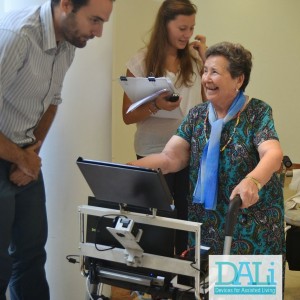The population of the advanced countries is ageing. This simple and widely recognised fact has important implications for health, society and economics. The most evident is in the number of people who report activity limitations, which grows significantly with age as clearly shown in the following chart. Activity limitations have an adverse effect on a person’s productivity, on the quality of her social relations and, ultimately, on her quality of life.
Policy makers confronted with a problem of challenging complexity: how to develop an effective strategy to fight the physical and cognitive decline of older adults in the face of ever shrinking financial resources for health care and social services.
In this context, technology can be of considerable help to care–givers to extend the range and the efficacy of their actions. The ACANTO project aims to develop a portfolio of technical solution that can serve this purpose. More specifically, our goal is to spur older adults into a sustainable and regular level
of physical exercise under the guidance and the supervision of their carers.
The key elements of ACANTO are a robotic friend (the FriWalk) that sup-ports the user in the execution of daily activities that require physical exercise and an intelligent system that recommends activites that a senior user perceives as compelling and rewarding.
The FriWalk takes the form of a standard walking assistant, but it is in fact an intelligent robot that is able to localise itself, to sense the surrounding environment, to plan a course of action that suits the user needs and to guide the user along safe routes. The FriWalk is also a personal trainer that can
support the user in the execution of a training programme, monitor the motion of the user in search of muscular or gait problems and report them into the user profile (that can be inspected by doctors and physicians).
The second key idea of ACANTO is that physical exercise is actually “concealed” within compelling activities (such as shopping, taking walks in museums and exhibitions etc.). Such activities have a social dimension (they are proposed to group of users) and are chosen based on the interest and on the past experiences of the user. At the heart of the recommendation system there is a social network which is created and developed by primarily using information collected by the FriWalk using “physical” observations on her behaviour and on her emotional state. For this reason, we call this social network “cyberphysical”.
Example use case
ACANTO’s ideas and philosophy are best illustrated using an example use case.
 Katerina is 73. Her health is not too bad; she is cognitively intact but she suffers from the post-traumatic consequences of a fall. Her doctor suggests that a complete rehabilitation would be easier if she walked for at least 20 minutes a day, but she has grown a little lazy in doing her exercises, and her social network is sparse. The past observations of her behaviour reveal a good degree of social awareness: she always stops at the booths of non-profit organisations.
Katerina is 73. Her health is not too bad; she is cognitively intact but she suffers from the post-traumatic consequences of a fall. Her doctor suggests that a complete rehabilitation would be easier if she walked for at least 20 minutes a day, but she has grown a little lazy in doing her exercises, and her social network is sparse. The past observations of her behaviour reveal a good degree of social awareness: she always stops at the booths of non-profit organisations.
She has not been out of her home for two days. When she looks at her tablet and connects to the social network, she finds that it proposes a shopping trip. The device suggests a list of supplies considering Katerina’s typical purchases. In addition, the tablet proposes that she runs some small errands for other people. For instance, Hana wants to know if a body cream she needs is available on the shelves of a shop in the mall because the last few times she checked it was not there. Peter needs fresh milk and he lives very close to Katarina’s home. The possibility of feeling useful to other people defies Katerina’s mental resistance; following the directions on her tablet she takes the bus and reaches the mall. She plugs her tablet into a FriWalk, which, in her case, will act as a useful shopping trolley. The device guides her through the execution of her shopping tasks, suggesting the most convenient places to buy goods; the selected shops have been rated as convenient by the cyberphysical social network because it has been observed that first time buyers frequently come back. During the execution of her shopping, Katerina is notified about the places where she must perform her other tasks (e.g., to take a picture to the shelf where Hana is patiently waiting for her body cream to materialise).
Because of Katarina’s profile and of the prescription of her doctor, the Fri-Walk is confident that she is physically capable to reach this destination within half an hour, walking 1.0 km in total. The haptic interface stimulates the correct stepping rhythm while the FriWalk adapts the inertia felt by Katerina to
her level of tiredness. In the end of her walk, the system challenges Katerina with an unexpected situation. When she reaches the nice cafeteria where the system guides her to take some rest, she meets Paul, who uses the same device and has a very similar profile to hers. Chances are that they will arrange to meet again soon.

